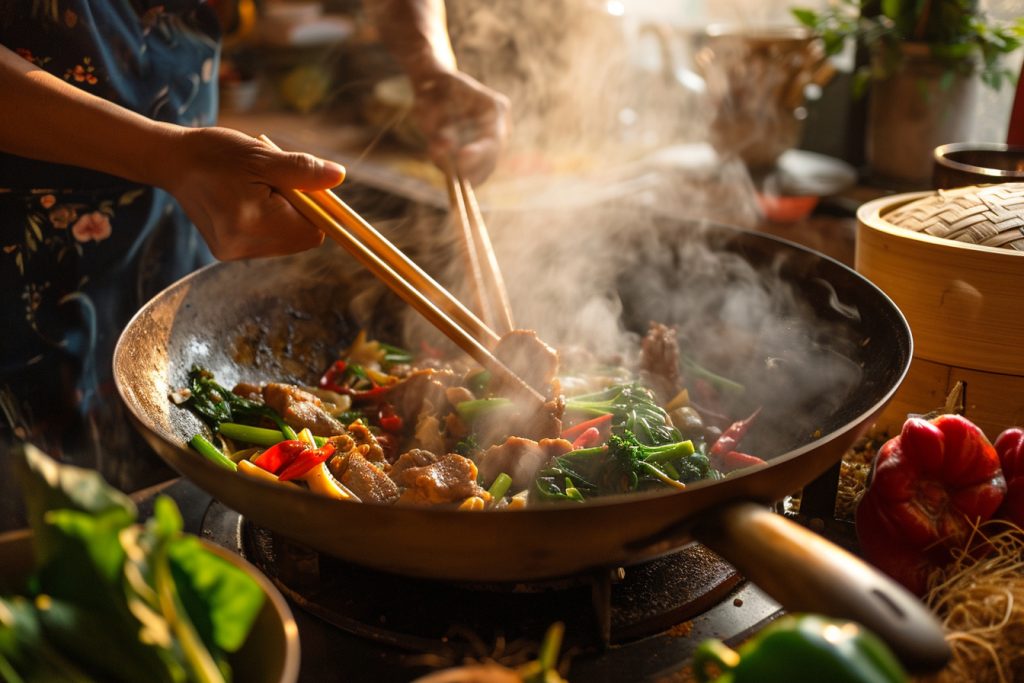Whipping up authentic Asian eats in your kitchen is like taking a culinary journey across countries, soaking up the rich flavors, and savoring the exotic spices. From the bustling street markets of Bangkok to the cozy noodle houses of Tokyo, each dish tells a story of tradition and gastronomy. But before you can recreate these mouthwatering meals at home, knowing what to stock in your pantry, mastering the fundamental techniques, and having a go-to collection of recipes is key. So, grab your wok, and let’s dive into the vibrant world of Asian cooking, one delicious bite at a time!
Stocking Your Pantry with Asian Staples
To begin your adventure in Asian cooking, curating a pantry filled with the right ingredients is essential. Make space for bottles of soy sauce, both light and dark, as they add that quintessential umami flavor to dishes. Rice vinegar, sesame oil, oyster sauce, fish sauce, and hoisin sauce should also find a home on your shelves. These condiments form the backbone of many Asian recipes, imparting depth and complexity with just a dash or drizzle. Don’t forget to stock various noodles such as soba, udon, and rice vermicelli, along with different types of rice, including jasmine and sushi rice, to complete the carbohydrate component of your pantry.
For the fragrant notes that define so many dishes, you’ll want to gather a selection of spices and aromatics. Keep on hand fresh ginger, garlic, lemongrass, and chili peppers, as well as dried spices like star anise, Szechuan peppercorns, and turmeric. These ingredients are pivotal in creating the signature flavors of Asian cuisine. As for the dry goods, a range of lentils, beans, and dried mushrooms will add texture and nutritional value to your meals. Don’t underestimate the power of having a well-stocked Asian pantry—it’s the first step in bringing the essence of Asia into your cooking.
Mastering Fundamental Asian Cooking Techniques
While ingredients are important, mastering the fundamental techniques of Asian cooking will truly elevate your homemade dishes. Stir-frying is a quick and hot affair; high heat and rapid movement are its hallmarks. It’s not just about tossing ingredients around—timing is key to ensure everything cooks evenly. Begin with the aromatics, like garlic and onions, then add your main ingredients according to their cooking times, and always have your sauce ready to pour in as you near the finish line. The result should be a harmonious blend of flavors and a pleasing crunch.
Another technique frequently used is steaming, which gently cooks food and retains its nutrients. This method is perfect for delicate items like fish and dim sum dumplings. And let’s not overlook the art of rolling and wrapping: from spring rolls to sushi, mastering the skillful tuck-and-roll can turn ingredients into neat, bite-sized packages ready for dipping or wasabi daubs. Be patient with your technique; practice makes perfect, and soon, the rhythmic chopping, stirring, and rolling of Asian cooking will feel as natural as boiling water.
Easy-to-Follow Authentic Asian Recipes
Starting with familiar dishes is a great way to become more comfortable with Asian cooking. Take, for instance, the classic Pad Thai—a symphony of tangy tamarind, sweet palm sugar, and nutty peanut flavors. It’s a street food favorite that you can easily craft at home. Begin by soaking the rice noodles, preparing a quick sauce, and stir-frying your chosen proteins with eggs. Finish by tossing everything in the sauce and garnish with crushed peanuts and fresh cilantro. Voila—a taste of Thailand in your dining room!
For those who crave the taste of Japan, a simple miso soup can warm your soul. Miso paste mixed with dashi stock forms the base, and from there, you can add tofu, seaweed, and spring onions. Ready in minutes, this simple yet profound soup encapsulates the elegance of Japanese cuisine. Or maybe you’re hankering for some comforting Chinese fare? Whip up a batch of Kung Pao chicken with a balance of spicy, sweet, and tangy flavors. Remember, cooking these dishes at home lets you control the quality of ingredients and the level of spice, making it a healthier alternative to takeout without skimping on flavor.
There you have it—transforming your kitchen into a haven for authentic Asian cooking is a rewarding expedition that starts with a well-stocked pantry, progresses through mastering techniques, and culminates in the joy of sharing homemade meals. These dishes are more than just food; they represent culture, tradition, and the warmth of home. With a little prep and practice, even the most exotic Asian eats can become your weeknight favorites. So go ahead, experiment with flavors, and enjoy the delicious results of your culinary creations. Here’s to many flavorful adventures on your plate!









